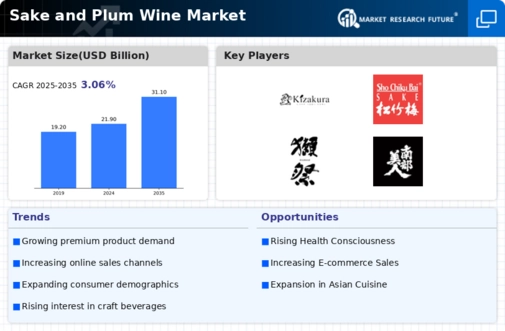The Sake and Plum Wine Market is vibrant and competitive, shaped by various domestic and international players who contribute to a dynamic landscape. Sake, a traditional Japanese alcoholic beverage made from fermented rice, has seen increasing popularity beyond its native country, while plum wine, often sweet and flavored, has carved its niche in this sector. The market is characterized by a growing consumer demand for unique and authentic experiences, as well as a rise in the popularity of Asian cuisine globally.
Moreover, innovative marketing strategies and increased accessibility through online channels have improved market dynamics, allowing brands to reach a broader audience. The competitive environment features a blend of established brands and emerging players, each vying for market share through quality, pricing strategies, and product differentiation. Kizakura stands out in the Sake and Plum Wine Market due to its commitment to producing high-quality sake that integrates traditional brewing techniques with modern practices. With a strong heritage that emphasizes craftsmanship, Kizakura has established a reputation for its flavorful offerings that resonate well with both domestic and international consumers.
The company leverages its extensive experience in sake production to ensure consistency and excellence in taste, which appeals to discerning customers. Kizakura’s strategic expansion into markets enables it to cater to diverse palates while maintaining the authenticity of its products, thus solidifying its position as a preferred choice among sake enthusiasts.
The company also actively engages in promotional collaborations and events that enhance its visibility, creating a loyal customer base that appreciates the brand's authenticity and quality.Takara Sake USA has positioned itself effectively within the Sake and Plum Wine Market, showcasing a wide range of sake products that cater to various consumer preferences. The company prides itself on its innovative approach, which combines the art of traditional sake brewing with contemporary flavors and packaging.
By focusing on quality ingredients and sustainable practices, Takara Sake USA has built a strong reputation for its premium offerings that resonate with health-conscious and environmentally aware consumers. Their strategic distribution network ensures that their products are readily available in multiple retail channels, further enhancing market accessibility. In addition, Takara Sake USA actively participates in industry events and tastings, which not only promote their brand but also educate consumers about the rich culture and history behind sake, thereby fostering appreciation and inspiring growth within the market.





